The race for electric supremacy among compact SUVs heats up with two of the most anticipated models of 2024: the BMW iX2 and the Volvo EC40. Both vehicles showcase the latest innovations in electric mobility, but which one stands out in terms of performance, technology, and overall experience? Let’s dive into the details of each model.
BMW iX2 vs Volvo EC40 – Which one offers the better deal?
Both models have their strengths – but which one suits you more?
Compare performance, efficiency, price and space directly: BMW iX2 or Volvo EC40?
Power and Performance
When it comes to power, the BMW iX2 offers two variants, delivering between 204 to 313 HP, and showcasing impressive torque of up to 494 Nm. With acceleration from 0 to 100 km/h taking just 5.6 seconds in the higher variant, BMW clearly emphasizes a sporty experience. In contrast, the Volvo EC40's rear-wheel-drive configuration delivers 238 to 252 HP with a respectable torque of 420 Nm. The EC40 is slightly behind in terms of acceleration, achieving 0-100 km/h in 7.3 seconds, but its performance is still commendable for a compact SUV.
Electric Efficiency and Range
Efficiency is key in the electric vehicle segment, and both models make significant strides with their energy consumption. The iX2 consumes between 15.9 to 16.9 kWh/100km, while the EC40 offers slightly higher consumption rates of 16.2 to 16.7 kWh/100km. However, the EC40 excels in range, providing an impressive maximum of 584 km, while the iX2 achieves a range of up to 459 km. This factor may sway potential buyers who prioritize longer trips without frequent charging interruptions.
Battery and Charging
The BMW iX2 comes equipped with a battery capacity ranging from 64.8 kWh, enabling a balanced performance and weight management with a curb weight of 1960 kg. Meanwhile, the Volvo EC40 features a larger battery capacity, up to 79 kWh, making it heavier at about 2065 kg. Despite the weight, the EC40's significant range could justify the extra burden for those who prioritize distance over nimble handling.
Interior Space and Comfort
Comfort is another critical consideration in the SUV segment. The BMW iX2 provides ample passenger space with a trunk capacity of 525 liters, making it suitable for families or users needing additional storage. The Volvo EC40, while slightly smaller in trunk capacity at 404 liters, still offers enough room for everyday use. In terms of dimensions, the iX2 measures 4554 mm in length, with a height of 1560 mm, whereas the EC40 is slightly shorter at 4440 mm and taller at 1591 mm. This translates into a roomier atmosphere in the Volvo, particularly with its height advantage.
Innovative Features and Technology
On the technological front, both vehicles are equipped with the latest electric vehicle technologies. The BMW iX2 features an intuitive infotainment system with advanced driver-assist features, ensuring an engaging driving experience paired with robust safety features. The iX2 also stands out with its sleek digital cockpit that enhances the driving vibe. On the other hand, the Volvo EC40 boasts its renowned safety innovations with advanced driver-assistance systems, providing peace of mind for drivers and passengers. Volvo's commitment to sustainability extends to its materials, as the EC40 incorporates recycled materials in its interior design.
Conclusion: Which SUV Comes Out On Top?
In conclusion, the choice between the BMW iX2 and Volvo EC40 ultimately revolves around personal priorities. The iX2 excels in sporty performance, trunk space, and a high-tech experience, while the EC40 stands out with longer range and a taller, possibly more comfortable interior. Both SUVs embody the transition towards electric mobility, offering unique advantages in their pursuit of eco-conscious driving. Deciding which one takes the crown will ultimately depend on what the driver values most: performance or efficiency, space or style.
Here’s where it gets real: The technical differences in detail
Costs and Efficiency:
Looking at overall running costs, both models reveal some interesting differences in everyday economy.
BMW iX2 has a minimal advantage in terms of price – it starts at 43100 £, while the Volvo EC40 costs 46600 £. That’s a price difference of around 3506 £.
In terms of energy consumption, the advantage goes to the BMW iX2: with 15.30 kWh per 100 km, it’s barely noticeable more efficient than the Volvo EC40 with 16.20 kWh. That’s a difference of about 0.90 kWh.
As for range, the Volvo EC40 performs somewhat better – achieving up to 584 km, about 106 km more than the BMW iX2.
Engine and Performance:
Under the bonnet, it becomes clear which model is tuned for sportiness and which one takes the lead when you hit the accelerator.
When it comes to engine power, the Volvo EC40 has a evident edge – offering 442 HP compared to 313 HP. That’s roughly 129 HP more horsepower.
In acceleration from 0 to 100 km/h, the Volvo EC40 is clearly perceptible quicker – completing the sprint in 4.60 s, while the BMW iX2 takes 5.60 s. That’s about 1 s faster.
There’s no difference in top speed – both reach 180 km/h.
There’s also a difference in torque: Volvo EC40 pulls evident stronger with 670 Nm compared to 494 Nm. That’s about 176 Nm difference.
Space and Everyday Use:
Whether family car or daily driver – which one offers more room, flexibility and comfort?
Both vehicles offer seating for 5 people.
In curb weight, BMW iX2 is barely noticeable lighter – 1960 kg compared to 2065 kg. The difference is around 105 kg.
In terms of boot space, the BMW iX2 offers noticeable more room – 525 L compared to 404 L. That’s a difference of about 121 L.
In maximum load capacity, the BMW iX2 performs to a small extent better – up to 1400 L, which is about 204 L more than the Volvo EC40.
When it comes to payload, BMW iX2 slightly takes the win – 510 kg compared to 435 kg. That’s a difference of about 75 kg.
Who wins the race?
The Volvo EC40 proves to be dominates this comparison and therefore becomes our DriveDuel Champion!
Volvo EC40 is the better all-rounder in this comparison.
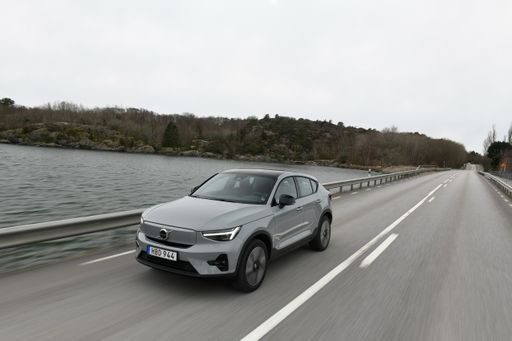 @ Volvo Cars
@ Volvo Cars
Volvo EC40
BMW iX2
The BMW iX2 stands out with its distinctive design and forward-thinking technology, making it a captivating choice for those interested in luxury electric vehicles. Its spacious interior and cutting-edge features offer both comfort and innovation, providing an exceptional driving experience. With a commitment to sustainability, this model is not just a statement of style but also an embodiment of the future of eco-conscious driving.
details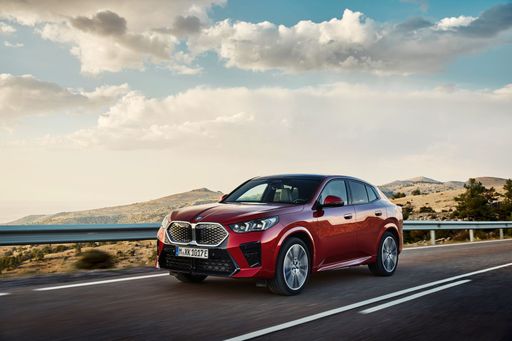 @ BMW Group Press
@ BMW Group Press
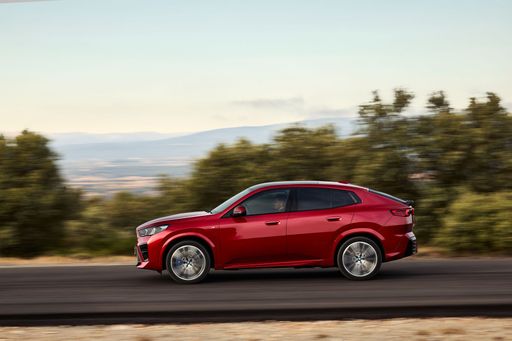 @ BMW Group Press
@ BMW Group Press
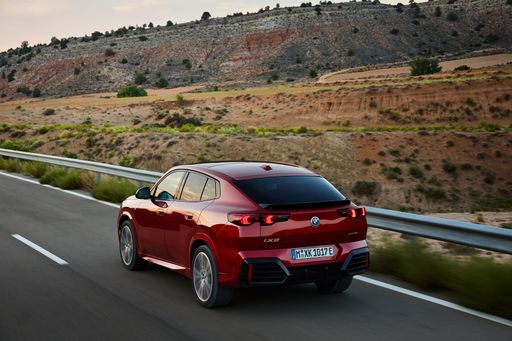 @ BMW Group Press
@ BMW Group Press
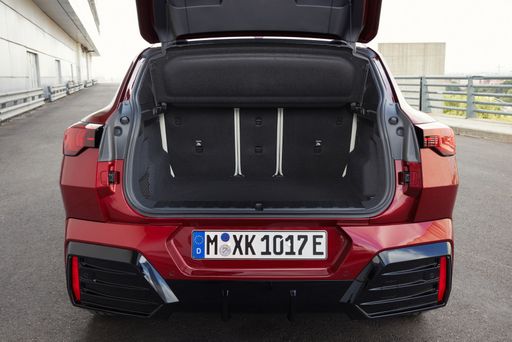 @ BMW Group Press
@ BMW Group Press
Volvo EC40
The Volvo EC40 seamlessly combines cutting-edge technology with sleek Scandinavian design, offering a refined driving experience. With its advanced safety features and user-friendly infotainment system, this model caters to both seasoned drivers and modern tech enthusiasts. The vehicle's impressive efficiency and environmentally conscious engineering make it a standout choice for those seeking sustainability without compromising on style.
details @ Volvo Cars
@ Volvo Cars
 @ BMW Group Press
@ BMW Group Press
|
 @ Volvo Cars
@ Volvo Cars
|
|
|
|
Costs and Consumption |
|
|---|---|
|
Price
43100 - 54800 £
|
Price
46600 - 59000 £
|
|
Consumption L/100km
-
|
Consumption L/100km
-
|
|
Consumption kWh/100km
15.3 - 16.3 kWh
|
Consumption kWh/100km
16.2 - 17.3 kWh
|
|
Electric Range
449 - 478 km
|
Electric Range
488 - 584 km
|
|
Battery Capacity
64.80 kWh
|
Battery Capacity
67 - 79 kWh
|
|
co2
0 g/km
|
co2
0 g/km
|
|
Fuel tank capacity
-
|
Fuel tank capacity
-
|
Dimensions and Body |
|
|---|---|
|
Body Type
SUV
|
Body Type
SUV
|
|
Seats
5
|
Seats
5
|
|
Doors
5
|
Doors
5
|
|
Curb weight
1960 - 2095 kg
|
Curb weight
2065 - 2185 kg
|
|
Trunk capacity
525 L
|
Trunk capacity
404 L
|
|
Length
4554 mm
|
Length
4440 mm
|
|
Width
1845 mm
|
Width
1873 mm
|
|
Height
1560 mm
|
Height
1591 mm
|
|
Max trunk capacity
1400 L
|
Max trunk capacity
1196 L
|
|
Payload
500 - 510 kg
|
Payload
395 - 435 kg
|
Engine and Performance |
|
|---|---|
|
Engine Type
Electric
|
Engine Type
Electric
|
|
Transmission
Automatic
|
Transmission
Automatic
|
|
Transmission Detail
Reduction Gearbox
|
Transmission Detail
Reduction Gearbox
|
|
Drive Type
Front-Wheel Drive, All-Wheel Drive
|
Drive Type
Rear-Wheel Drive, All-Wheel Drive
|
|
Power HP
204 - 313 HP
|
Power HP
238 - 442 HP
|
|
Acceleration 0-100km/h
5.6 - 8.6 s
|
Acceleration 0-100km/h
4.6 - 7.3 s
|
|
Max Speed
170 - 180 km/h
|
Max Speed
180 km/h
|
|
Torque
250 - 494 Nm
|
Torque
420 - 670 Nm
|
|
Number of Cylinders
-
|
Number of Cylinders
-
|
|
Power kW
150 - 230 kW
|
Power kW
175 - 325 kW
|
|
Engine capacity
-
|
Engine capacity
-
|
General |
|
|---|---|
|
Model Year
2024
|
Model Year
2024
|
|
CO2 Efficiency Class
A
|
CO2 Efficiency Class
A
|
|
Brand
BMW
|
Brand
Volvo
|
What drivetrain options does the BMW iX2 have?
The BMW iX2 is available as Front-Wheel Drive or All-Wheel Drive.
The prices and data displayed are estimates based on German list prices and may vary by country. This information is not legally binding.
